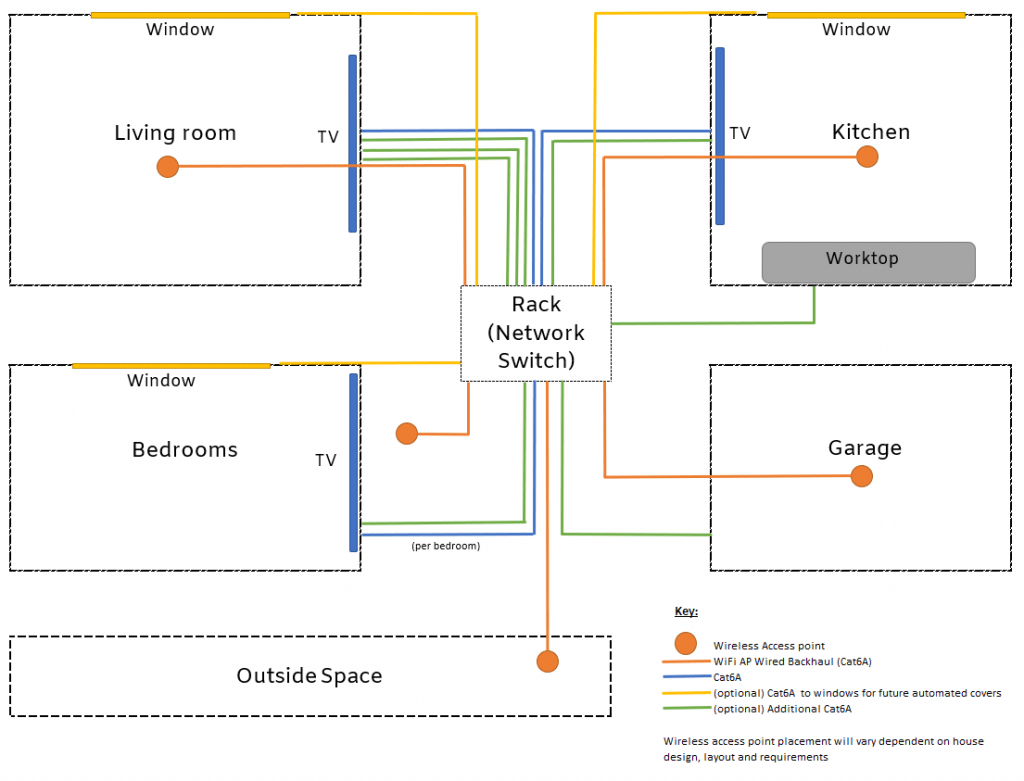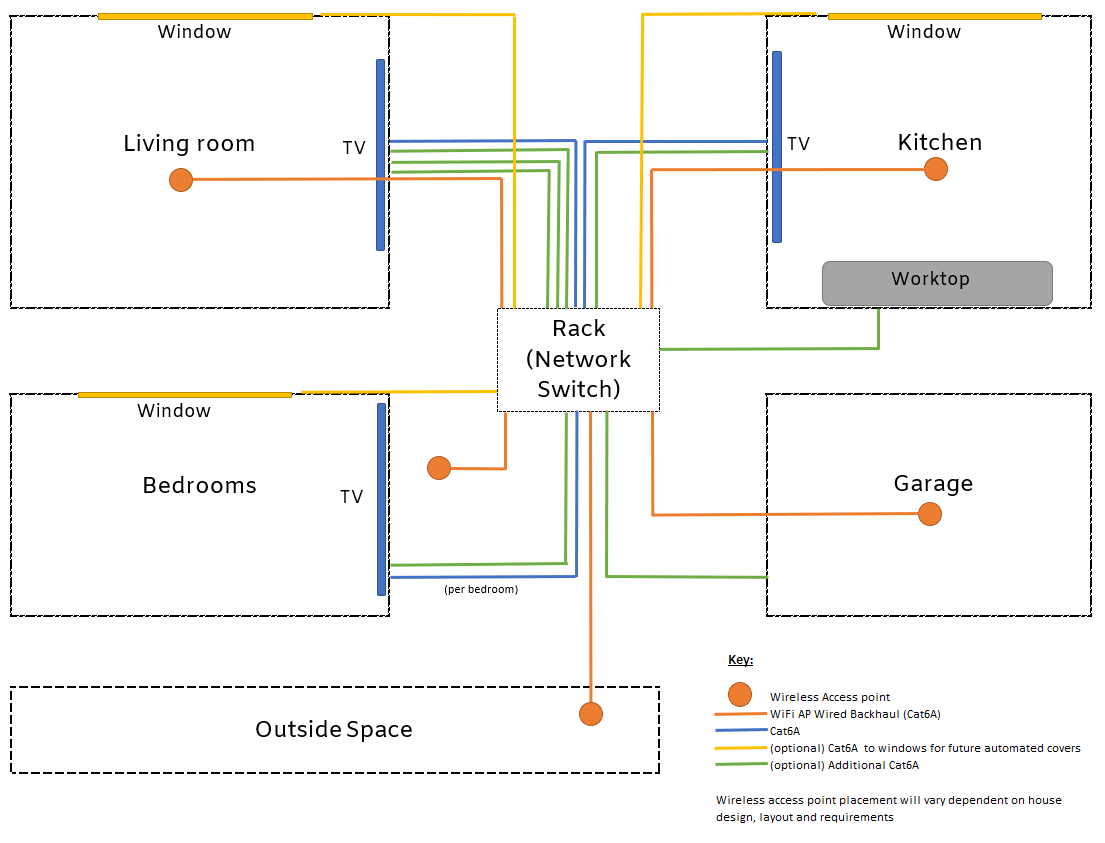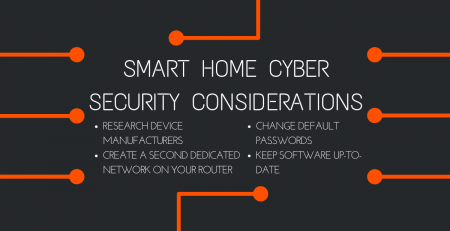Smart Home Choices Wired vs. Wireless
Estimated reading time: 10 minutes
Introduction
A question we get asked a lot by people doing major home renovations or a new build is whether they should include hardwired network connections throughout the home. As with all questions there is no one right answer and the best solution for you will depend on a number of factors.
As big fans of shows like Grand Designs, I think that this often gives the impression that to include hardwired systems involves kilometres of cabling and a unit the size of a larder fridge to accommodate in a cupboard somewhere. But there are other options and it is often the case that a hybrid solution of wired and wireless gives the optimum connectivity to suit your requirements.
In this blog we’ll guide you through the options and the things that might influence your choices.
By the end of the article you should feel more informed and confident to discuss your requirements with your electrician or smart home integration specialist.
About Our Blog
We live in an ageing society. But what does that really mean?
In the next 20 years the balance of young and old will shift to the point where there will be one elderly person for every two people of working age. The challenge this presents is two-fold, a reduction in family members able to provide support and a smaller pool of professional carers.
TL Tech is a Smart Homes Solutions provider with a difference. We help people get the best out of smart home technologies and create unique home environments to meet their needs and budget. Our vision is to “create a home that cares for you as you age”.
Smart home technologies have the power to transform lives, especially for the vulnerable in our society. This blog series will be looking to showcase the opportunities, find out more about the people working in this field and how we can create a world where “smart meets kind” ®.
All You Need to Know About Creating a Smart Home
What is a smart home and what can a smart home do?
The word smart is used to describe when functions within the home can be controlled either remotely, automatically or through a non-traditional interface. To be truly smart the functions within the home should be able to be integrated together to allow associations (also known as automations) between different activities and programming of new ways of operating the devices within the home to adapt continuously to requirements. Fundamentally, a smart home should enhance the way that you live, bringing greater security, wellbeing and enjoyment.
The benefits of living in a smart home are wide ranging and will be personal to each situation. There are four main areas in the home that a smart system adds value:
- Heating – radiator thermostats, temperature/humidity sensors, heating pump control, air conditioning
- Lighting – remote switching (through mobile phone, tablet, bespoke button, timer – can also be linked to motion or light levels), electronic blinds and curtains
- Audio visual – TV/home cinema control, speakers, screens for video calling
- Security – doorbells, cameras, motion detectors, door/window sensors
There are four important design influences to consider
There are a lot of things to consider when designing a smart home. The top four influences are:
- Lifestyle – do you already use a lot of electronic devices, do you like to have music on throughout the house, are you away from home a lot, are you looking for convenient time saving solutions or ways to reduce your energy consumption?
- Your home – is it an existing property, are you renovating or self-building? With new builds and major renovations there is more opportunity to install cables.
- Cost – what is your budget, can you afford a larger initial outlay? You should also factor in maintenance costs.
- Future needs – are you a growing family, would you like your home to accommodate multi-generational living, what about changes in your health and mobility? It’s worth considering also that technology is constantly evolving and discovering new use cases, so if you already have a room set-up for internet connected devices, this can make future adaptation easier.
If you can identify what is important to you and where there are potential constraints, this helps you talk to potential smart home installers about your project requirements. A good installer will want to get to know more about these things, so that you get a system that truly meets your needs. They will be able to suggest solutions based on their experience to bring your ideas to life.
What are the technical design choices?
We’re not going to go into detail on all the design choices, as there is far too much to cover in a single blog post. Instead we’ll focus on the primary decision which is whether to go for a wired or a wireless smart home? Note that for both options you will want to investigate the internet capability at your property or plot. As this may present a significant limitation on the ability of the network to stream data. Depending on how you design the system you will also need to think about back-up power so that the smart home can remain operational in the event of a powercut, this is especially important for hardwired security systems.
| Wired | Wireless | |
| Requirements | Ethernet cables Space for network equipment, you will need a location where all the cabling comes back to. This is normally the location you choose to have the main telecoms incomer to the house (the BT master socket) | Good WiFi coverage (many need range extenders, or hardwired wireless access points) and/or You could choose smart devices that communicate over Zigbee as each device extends the coverage of the system. |
| Type of property | New build or major renovation | Existing home, rental property |
| Installation Costs | £££ | £-££ |
| Upgrade Costs | ££ | £ |

Based on the analysis above you will see that for many homes a hybrid solution can optimise the balance between functionality and cost.
Frequently asked questions
As you’ll have gathered from the above discussion, there are loads of ways to create a connected smart home. The technical design choices can be quite daunting, but don’t be afraid to ask for more information from your smart home designer or supplier.
Q. What’s the difference between all the different types of data or ethernet cable?
One thing we get asked quite a lot is “What’s the difference between Cat 5 and Cat 6 ethernet cable?” In most cases the world of technology tends to add a number to the name when a new improved design is released. In simple terms Cat 6 cables can support faster data transfer than Cat 5 cable and can also support higher Power Over Ethernet (POE) requirements. Your smart home installer will be able to explain more about the choices and specify the right cable for your project.
Q. Where should the network cabling go?
Our recommendation is to have a minimum of one hardwired network connection in every room and ideally one dedicated to each television to allow streaming services to have the best possible connection. You will want to look at the layout and plans for your home to visualise where you will position the new smart devices, to ensure that they have the power supply and internet connection that they need. Things like smart ovens and kitchen appliances are growing in popularity so don’t forget the kitchen in your plans.
Sometimes overlooked areas include garages and outside spaces. If you might want to automate your garage door or driveway gate or add external security cameras, having Ethernet cabling out to these locations is a good investment and easier to do at this stage than when your project is complete.
Another growing trend is for smart window coverings, these again are best hardwired (due to their requirement for power for the motor more than the control side of things) and can be really invaluable for large windows that may be hard to reach but where you want to have control over the light levels or temperature in the building.
To help you visualise the layout of the wiring we’ve created a handy schematic which you can download and print.

Q. How much does a smart home installation cost?
We would advise to budget a similar amount to what you might spend on a kitchen, including appliances and fitting. Or another budgeting analogy would be how much you would spend buying a new car. So if you are planning a renovation or build, and have budgeted £15,000 for the kitchen, then a smart home system of matching quality will set you back about the same. The cost is very dependent on what functionality and features you want and the finish you are looking for. If you have a cinema room on your wish list for example this will add significantly to the cost.
You can keep the costs down by applying a hybrid approach, as discussed above, and by doing some of the work yourself to run the cabling. But this involves a bit more technical knowledge and time input.
The wide availability of consumer electronics now means that you can create wireless smart home solutions on a fairly modest budget and add elements to your system as your finances allow. If you are going for a fully wireless design expect to pay from £10 for a smart bulb, through to over £200 for a smart heating starter kit or smart security starter kit. Even with wireless solutions we recommend getting some advice, to make sure that the hardware you are purchasing is compatible and to get help with integrating the devices together to improve the usability of the system, so you probably want to budget a bit more for this design and installation support.
Choosing you home automation specialist
A home automation specialist is a bit like a plumber for the smart home world. You may find that certain smart home installers have preferred brands and systems, or may only specialise in certain areas of the smart home. Others like TL Tech have programming capability as well as the electrical/electronics skills and can integrate different systems together to create bespoke solutions as well as more standardised packages.
We are based in Aberdeenshire in the North East of Scotland if you are looking for someone in the Grampian region, or we can help recommend someone closer to you.
The main trade body for smart homes is the Custom Electronic Design and Installation Association (or CEDIA for short). Members of CEDIA will have undertaken training to ensure they are competent in all aspects of installation, including health and safety. Their website has guidance for homeowners which covers in more depth some of the aspects we have discussed in this blog piece.
Useful links
https://www.tltechsmart.com/faq/
https://cedia.net/homeowners/tech-101
https://cedia.net/homeowners/tips-for-success/steps-for-a-successful-home-technology-project
Key Pieces of Advice
If you are undertaking renovations, home improvements or are lucky enough to be building your dream house, our key pieces of advice when it comes to smart technologies are:
- Start to plan your project early and get input from a specialist. Think about your lifestyle and the design of your home. Don’t be afraid of speaking to a range of home automation specialist to find the one most suited to your project.
- Talk to others who have a smart home. Ask them what they love about their home, what they wish they’d done differently.
- Think about your future needs. If this is your forever home, you want to make sure that it can adapt as your needs change. Smart home technology can help to support you to maintain your independence and wellbeing.
If you liked this post, check out our website for more technical advice. You can also subscribe to our mailing list to be notified when we have new posts and support material available.
If you are looking to create a smart home on a budget, we have a great free 14 page eBook that guides you through in more detail some of the design choices and our favourite budget buys. You can access this via the header bar on our website by subscribing to the mailing list or drop us an email to info@tltechsmart.com and we’ll send you an electronic copy. We love to hear your stories of how you are using smart home technologies and any tips that you might have discovered to share with others, so please do get in touch also on our social media channels.












Comments (2)
Your blog about Smart Home Choices Wired vs. Wireless is an amazing blog. It is filled with rich info. Thanks a lot for sharing such a wonderful blog.
Thanks so much for the lovely feedback, we are glad you found it helpful.